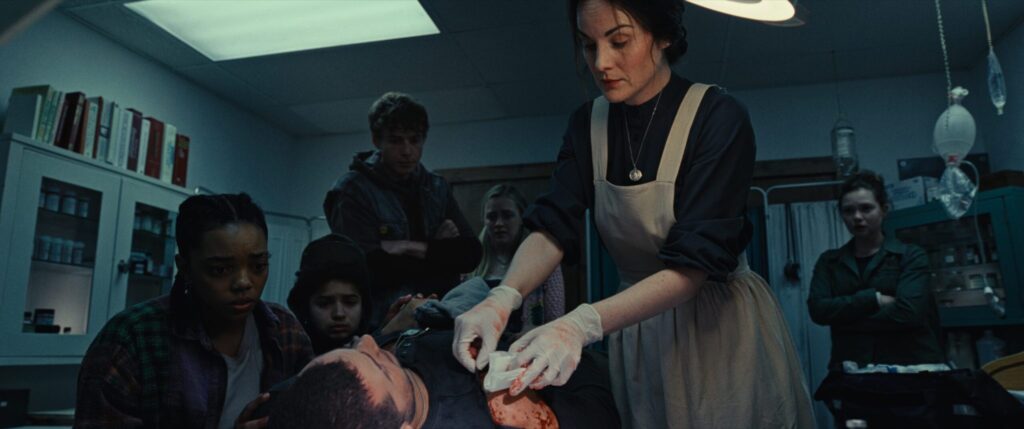Destry Allyn Spielberg’s directorial debut, “Please Don’t Feed The Children”, is set to be one of the most intriguing films of 2024, largely due to its dark narrative and bold casting decisions. Among the film’s key players, Michelle Dockery, known for her poised, aristocratic roles, steps into the role of a villain—a departure from her typical characters. The first-look images from the film showcase Dockery’s menacing portrayal, giving audiences a glimpse of the chilling antagonist she embodies. This marks a pivotal moment in Dockery’s career, while also demonstrating Spielberg’s directorial vision, which seems intent on exploring darker, more challenging material. This explication will focus on Dockery’s performance as revealed in these early images, how this role contrasts with her past work, and what it suggests about Spielberg’s direction in her debut feature.
The Film’s Dark Premise
“Please Don’t Feed The Children” is an apocalyptic thriller set in a world where society has collapsed, and a group of orphaned children are left to fend for themselves. The tension in the film arises from these children’s vulnerability juxtaposed against the harsh, dangerous adult figures they encounter—one of whom is Michelle Dockery’s villainous character. Spielberg’s vision, as captured in the first images, seems steeped in dark, moody aesthetics, with the setting and characters painted in stark, unforgiving light. The desolate landscapes and hollow-eyed children reflect a narrative about survival, but Dockery’s character, shrouded in shadow and menace, emerges as a central antagonist who adds emotional and psychological layers to the plot.
This marks a significant thematic departure for Dockery, who has often portrayed elegant, morally upright characters, as well as for Spielberg, who steps into the director’s chair with an ambitious, harrowing story. The first images hint at a film that is not simply a thriller in the traditional sense but a character-driven exploration of how individuals exploit the vulnerable in times of crisis.
Michelle Dockery’s Career Transformation
Michelle Dockery’s portrayal of Lady Mary Crawley in “Downton Abbey” solidified her as a figure of aristocratic grace and strength. Lady Mary, while occasionally cold and calculating, always had a moral compass guiding her decisions. In contrast, “Please Don’t Feed The Children” presents Dockery in a role that strips away the refined exterior and replaces it with something far more sinister. The transformation is evident in the first images, where Dockery’s character is shown with a hardened expression, her costume and makeup choices emphasizing a stark, almost predatory presence.
Dockery’s career has seen her take on diverse roles since “Downton Abbey”, but this film marks one of her most drastic character shifts to date. In previous works such as “The Gentlemen” (2019), she played a more assertive, street-smart character, but still maintained a certain likability. In “Please Don’t Feed The Children”, Dockery’s role is devoid of any warmth, a deliberate move that places her at odds with the orphaned children who are at the heart of the film. This role could signify a new chapter in her career, where she breaks free from the constraints of period dramas and embraces more complex, darker characters.
The Villain Archetype: Dockery’s Evolution
Villains in cinema often embody the fears and anxieties of their respective societies, and Dockery’s role in “Please Don’t Feed The Children” seems to tap into contemporary concerns about authority figures, exploitation, and survival. The apocalypse setting allows her to play a character who likely manipulates and controls those weaker than her, a common archetype in dystopian narratives. However, what sets Dockery apart in this role is her ability to imbue characters with depth. Even in the limited imagery released so far, her performance hints at a villain who is not simply evil for the sake of the plot, but someone whose motivations and personal history may be explored in nuanced ways.
One of the most striking aspects of the first-look images is Dockery’s cold, calculating expression. Her facial features, often associated with elegance and beauty, are transformed into tools of intimidation. The costuming and makeup further distance her from the grace of Lady Mary; she appears more rugged and unkempt, matching the film’s dystopian atmosphere. Her clothes are darker, more utilitarian, suggesting a character focused on survival, potentially at the expense of others.
This role allows Dockery to evolve as an actress by embracing the villain archetype, while also exploring the complexity that often lies beneath such characters. Villains are rarely one-dimensional in modern cinema, and it is likely that Spielberg’s directorial vision will give Dockery room to craft a layered performance, turning her character into a representation of both power and fear.
Spielberg’s Vision: A Dark, Character-Driven Narrative
Destry Allyn Spielberg, the daughter of legendary filmmaker Steven Spielberg, carries the weight of great expectations with her debut. The early images from “Please Don’t Feed The Children” suggest that she is crafting a film deeply rooted in atmospheric tension and character development. While the apocalyptic setting is familiar in cinema, Spielberg seems to be focusing on the human element—how people react under extreme pressure, and how morality shifts when survival is at stake.
The decision to cast Dockery as the villain is a bold one, signaling that Spielberg is unafraid to challenge both her actors and her audience. Dockery’s casting is not just a departure for the actress, but also a signal of Spielberg’s intent to subvert expectations. By placing an actress known for elegance and refinement into a role that requires ruthlessness, Spielberg is making a statement about the unpredictability of human behavior in dystopian circumstances.
The first-look images are carefully crafted to emphasize this atmosphere. Dockery’s character looms large, both physically and emotionally, in the frames she occupies. The film’s muted color palette, combined with sharp contrasts in lighting, further accentuates the grim tone of the narrative. Spielberg seems to be drawing on visual storytelling techniques that heighten tension without relying on overt violence or action, focusing instead on the psychological threat that Dockery’s character represents.
Impression
Given its pedigree—both in terms of Spielberg’s family name and Dockery’s established career—“Please Don’t Feed The Children” is likely to have a significant cultural impression. The film’s dark themes resonate with contemporary anxieties about authority, the future of society, and the vulnerability of children in a world that seems increasingly dangerous. Dockery’s villain could become an emblematic figure in modern dystopian narratives, representing the corruption of power in apocalyptic settings.
Moreover, the film’s focus on children and their exploitation by figures of authority taps into a longstanding cinematic tradition of critiquing power dynamics. Spielberg’s decision to cast Dockery in this role suggests a deeper exploration of how individuals, especially women, navigate power in dystopian worlds. The film could serve as a commentary on the moral compromises people make in order to survive, and Dockery’s performance will likely be central to this exploration.
The first images from “Please Don’t Feed The Children” offer a tantalizing glimpse into what promises to be a bold and thought-provoking film. Michelle Dockery’s transformation into a villainous character marks a significant departure from her previous roles, and Destry Allyn Spielberg’s vision for the film suggests a complex, character-driven narrative set against a dystopian backdrop. As more details emerge, it will be exciting to see how Dockery’s performance unfolds and how Spielberg’s directorial debut positions her as a rising talent in the film industry. This film could very well redefine both actresses’ careers, while offering a dark, gripping story that resonates with contemporary audiences.
No comments yet.







